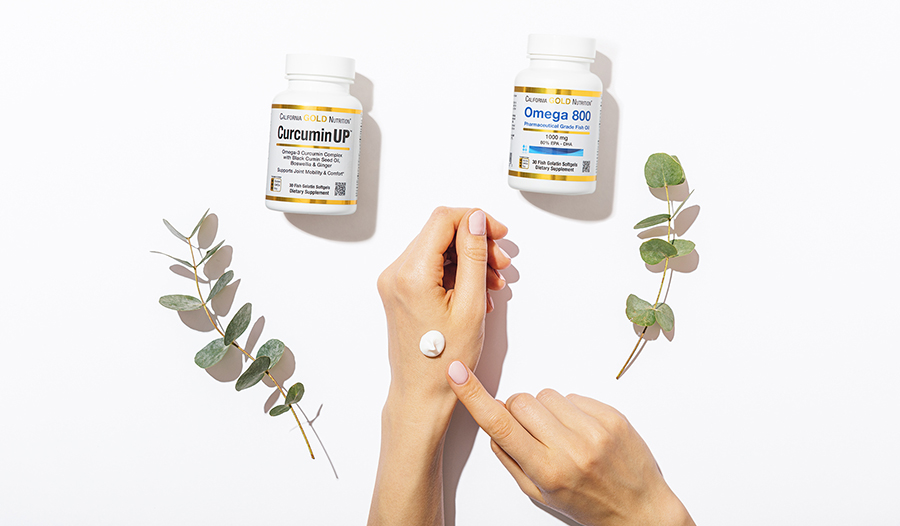7 Natural Approaches to Psoriasis
DISCLAIMER:This blog does not intend to provide diagnosis...
- In this article:
- What Is Psoriasis?
- 1. Oregon Grape (Berberine)
- 2. Aloe Vera
- 3. Omega-3 Fatty Acids
- 4. Turmeric
- 5. Capsaicin
- 6. Oats
- 7. Vitamin D
- The Big Picture

What Is Psoriasis?
Psoriasis is a skin disease considered an autoimmune disorder that causes itchy, raised, scaly plaques with a thick, red, bumpy base which are challenging to treat. Due to systemic inflammation, the plaques form due to skin cells multiplying ten times faster than expected. The plaques most affect the elbows, knees, scalp, and trunk, but they can develop anywhere on the skin’s surface. Psoriasis can also be triggered by stress, alcohol, cigarette smoking, cold, dry weather, and skin injury or infection.
Psoriasis flares can be mediated with various natural approaches for the longevity and health of your skin.
1. Oregon Grape (Berberine)
Best used as a topical skin cream for mild to moderate psoriasis, Oregon grape (Mahonia aquifolium) is a popular choice for individuals looking for natural options to treat their psoriasis plaques. Also known as berberine or barberry, Oregon grape has anti-inflammatory properties that reduce redness in psoriatic plaques. The leaves and stems of the plant are used to make the topical cream, which may cause a mild burning sensation when applied to the plaque.
In a clinical trial testing topical Oregon grape treatment for psoriasis, 84% of patients rated their psoriasis as having a good to excellent response to the cream. When compared with standard treatment, 63% of patients rated Oregon grape equal to or better than the standard psoriatic treatment.
Another study observed patients with mild to moderate bilateral psoriasis treated with Oregon grape for one month. The patients showed improvement in psoriasis after one week of treatment, and the side treated with Oregon grape cream did as well or better than the side treated with the control cream.
2. Aloe Vera
The cooling and soothing properties of aloe vera make it suitable for a wide range of topical skin applications, including psoriasis treatment. According to the Mayo Clinic, a topical cream containing a minimum of 0.5% aloe can be used to treat mild psoriasis flares. The cream should be applied one to three times daily for five days straight to decrease inflammation and help clear the flare. A break from the cream may be needed before the round of application to avoid skin irritation.
One clinical study looked at patients who had psoriasis for an average of eight and a half years ranging in age from 18 to 50. Patients were examined every week. Those showing a progressive reduction of lesions followed by decreased redness and swelling and lowered Psoriasis Area and Severity Index (PASI) score were considered healed. A PASI score is a tool used to measure the severity of psoriasis. A score of 5 to 10 is regarded as a moderate disease, and a score over 10 is considered severe. All the patients tolerated the treatment well, with no adverse symptoms.
By the end of the study, the Aloe vera extract cream had cured 25/30 patients (83.3%) compared to the placebo cure rate of 2/30 (6.6%), resulting in significant clearing of the psoriatic plaques (82.8%) vs. placebo (7.7%), and a decreased PASI score to an average of 2.2.
Aloe vera also has anti-aging properties, an additional benefit to applying aloe vera cream topically.
3. Omega-3 Fatty Acids
Eicosapentaenoic acid (EPA) and docosahexaenoic acid (DHA) are 2 long-chain omega-3 fatty acids found in abundance in fatty fish such as salmon and mackerel, as well as in algae. These healthy fats are unsaturated and promote heart health by lowering triglycerides and blood pressure in some individuals. The anti-inflammatory properties of omega-3 fatty acids may help patients with psoriasis.
A clinical study found that supplementary treatment with omega-3 fatty acids complements topical treatment in psoriasis and significantly contributes to reducing PASI scores. Omega-3 supplements were found to reduce scalp lesions, itching, redness, scaling, and swelling of the treated areas.
4. Turmeric
Curcumin, the primary anti-inflammatory compound in the golden orange–colored spice turmeric, can be applied topically to soothe and calm psoriasis skin plaques. Turmeric can also be taken orally to decrease systemic inflammation in psoriasis patients. Native to India and Indonesia, where it was used as a spice and a perfume in ancient times, curcumin decreases the expression of proinflammatory cytokines and growth factors such as interleukin-6 (IL-6) and IL-8 in human keratinocytes.
Keratinocytes play an active role in the initiation and maintenance of psoriatic skin inflammation by secreting chemokines and cytokines, which leads to further activation of immune cells in the skin. This, in turn, amplifies the inflammatory process. In addition, psoriatic keratinocytes have an increased proliferation rate, meaning they multiply more quickly than they should. Curcumin can help reduce these inflammatory processes within the keratinocytes, the primary cell type in the epidermis, or the uppermost layer of skin.
In psoriasis, immune cells enter the skin through blood vessels and cause the epidermis to grow very quickly, inhibiting the natural skin shedding process. The result is a thickening of the skin and the scaly buildup composed of dead skin cells that manifest as psoriasis plaques.
Turmeric’s powerful anti-inflammatory properties make it an excellent anti-aging herb because most chronic illnesses are caused by chronic inflammation. Incorporate turmeric creams and supplements for good health and longevity.
5. Capsaicin
Changes in the cutaneous (skin) vascular system are apparent in psoriasis and may play an essential role in the disease process. A clinical study evaluated the effects of topically applied capsaicin, a known inhibitor of cutaneous vasodilatation (widening of the blood vessels), on moderate and severe psoriasis.
The study found significantly more overall improvement in psoriasis plaques treated with capsaicin than those treated with a control, nonmedicated cream. There were significantly greater reductions in scaling and redness on the plaques where the capsaicin topical cream was applied.
Almost half of the patients noted the burning, stinging, itching, and redness of the skin on the initial application of the capsaicin medication but diminished or resolved upon continued use of the topical capsaicin cream.
6. Oats
Soaking in an oatmeal bath can be soothing to inflamed psoriatic plaques. Oatmeal has been proven to reduce skin itching and swelling, with omega-3 and omega-6 fats being the primary ingredients contributing to these soothing effects. Studies have demonstrated that avenanthramides, active components in oats, can inhibit the release of proinflammatory cytokines and histamine. These are key mechanisms in the pathophysiology of inflammatory skin conditions such as psoriasis.
Use colloidal oatmeal, a finely ground oatmeal that dissolves in hot water and will not clog your drain. Start with 1/2 cup (4 ounces) of colloidal oatmeal and work up to as much 1as 1/2 cups (12 ounces) mixed into a warm bath.
Adding essential oils of lavender, chamomile, or bergamot to the bath water can add additional relief. Do not apply essential oils directly to the psoriatic plaques. Use caution when exiting the tub, as the oats can make the water slimy and slippery.
Pat yourself dry and avoid rubbing your skin harshly to avoid irritation. After you dry off, apply a mild skin moisturizer such as coconut oil to seal in moisture. The coconut oil will moisturize the skin and scales while adding additional anti-inflammatory properties to help soothe psoriatic plaques.
7. Vitamin D
Vitamin D deficiency has been linked to psoriasis. Vitamin D deficiency is not the cause of psoriasis, but low levels may increase flares and interfere with the body’s immune function and ability to keep the skin healthy.
Vitamin D taken orally or topically can help treat psoriasis. Taken as a supplement internally, vitamin D helps boost the immune system. Since psoriasis is an autoimmune disease, this can help alleviate symptoms of the disorder. Applied topically, vitamin D can slow the rate of cell proliferation or cell growth and hence help to thin psoriasis plaques.
You can also increase your vitamin D levels by exposure to sunlight—15 minutes a day for fair skin up to 30 minutes for darker skin—and from dietary sources. Foods high in vitamin D include fatty fish, such as tuna, mackerel, and salmon, and foods fortified with vitamin D, including some dairy products, orange juice, soy milk, and cereals.
Vitamin D is fat-soluble, so it is essential to have your doctor monitor your levels to avoid unhealthy buildup, also called hypervitaminosis D, or vitamin D toxicity. Hypervitaminosis can cause a buildup of excess calcium in the blood, which can cause frequent urination and weakness and can lead to kidney concerns. This is typically only caused by excessive doses of vitamin D supplements and is unlikely to occur from diet or sunlight exposure.
The Big Picture
There are many natural approaches to psoriasis treatment, from herbs such as turmeric and Oregon grape to supplements like vitamin D and omega-3 fatty acids. The soothing effects of aloe, the anti-inflammatory properties of topical oats, and the inhibition of cutaneous vasodilation by capsaicin topical cream each offer unique and effective natural alternatives for psoriatic plaque relief.
Trying each remedy one at a time could be the best way to know which one works best for you. After trying them individually, you may decide to combine the methods you responded to best for an effective psoriasis treatment plan for yourself. No matter your approach, these natural remedies for psoriasis should offer much-needed relief from your itchy, inflamed psoriatic plaques.
References:
- Balbás GM, Regaña MS, Millet PU. Study on the use of omega-3 fatty acids as a therapeutic supplement in treatment of psoriasis. Clin Cosmet Investig Dermatol.2011;4:73-77. doi:10.2147/CCID.S17220
- Barrea L, Savanelli MC, Di Somma C, et al. Vitamin D and its role in psoriasis: an overview of the dermatologist and nutritionist. Rev Endocr Metab Disord.2017;18(2):195-205. doi:10.1007/s11154-017-9411-6
- Bernstein JE, Parish LC, Rapaport M, Rosenbaum MM, Roenigk HH Jr. Effects of topically applied capsaicin on moderate and severe psoriasis vulgaris. J Am Acad Dermatol. 1986;15(3):504-507. doi:10.1016/s0190-9622(86)70201-6
- Cerio R, Dohil M, Jeanine D, Magina S, Mahé E, Stratigos AJ. Mechanism of action and clinical benefits of colloidal oatmeal for dermatologic practice. J Drugs Dermatol. 2010;9(9):1116-1120.
- Gulliver WP, Donsky HJ. A report on three recent clinical trials using Mahonia aquifolium 10% topical cream and a review of the worldwide clinical experience with Mahonia aquifolium for the treatment of plaque psoriasis. Am J Ther. 2005;12(5):398-406. doi:10.1097/01.mjt.0000174350.82270.da
- Sarafian G, Afshar M, Mansouri P, Asgarpanah J, Raoufinejad K, Rajabi M. topical turmeric microemulgel in the management of plaque psoriasis; a clinical evaluation. Iran J Pharm Res. 2015;14(3):865-876.
- Syed TA, Ahmad SA, Holt AH, Ahmad SA, Ahmad SH, Afzal M. Management of psoriasis with Aloe vera extract in a hydrophilic cream: a placebo-controlled, double-blind study. Trop Med Int Health. 1996;1(4):505-509. doi:10.1046/j.1365-3156.1996.d01-91.x

 By Dr. Carlie Biggins, N.D.
By Dr. Carlie Biggins, N.D.


